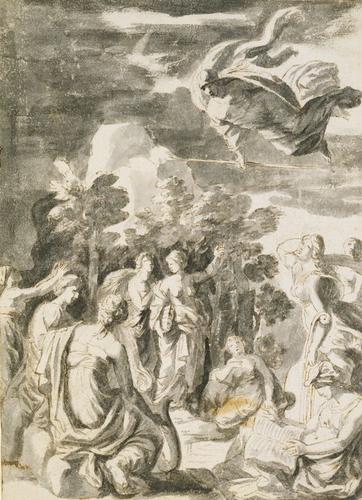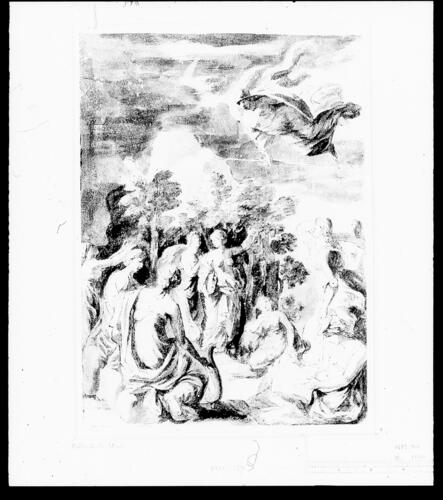-
1 of 253523 objects
Pallas and the Muses c.1622-23
Black chalk underdrawing, pen and brown-grey ink, grey wash | 22.2 x 30.5 cm (sheet of paper) | RCIN 911946
-
A drawing of Pallas visiting the Muses on Mount Helicon. A spring known as the Hippocrene flowed from a rock on the sacred Mount Helicon, home of the Muses, after it was struck by the hoof of the winged horse Pegasus. Ovid describes how Pallas, the goddess of learning and the arts, visited the Muses to inspect the miraculous fountain - though the spring itself, central to the episode, receives only the most cursory treatment.
Then Pallas to the sacred Spring convay'd,
Shee admires the waters by the horse-hoofe made;
Survay's their high-grown groves, coole caves, fresh bowrs,
And meadowes painted with all sorts of flowers.
(Metamorphoses, V, 250ff; trans. Sandys 1632)The drawing forms a pair with RCIN 911945, and may have been made for the poet Giovanni Battista Marino in Paris, though the pair are not en-suite with the other Marino drawings (see 911933). The use of a thick reed pen and much bolder chiaroscuro makes it difficult to compare the style of this and 911945 with the Marino drawings, but the handling and figure types are cruder than anything definitely from Poussin's Roman years, and a date around the same time as the Marino series seems most likely.
A copy of the drawing, in a Dutch private collection, is reproduced in Rosenberg & Prat 1994, p. 14.
A drawing in Stuttgart (Graphische Sammlung der Staatsgalerie, inv. 1384) showing Apollo slaying Python, while not by Poussin, may well be a copy of a lost sheet that once accompanied 911944-5. In size it falls between the two Windsor drawings, the figuration and rudimentary landscape are very similar, the subject is Ovidian, and the elaborate technique emulates their heavy chiaroscuro.Provenance
Cardinal Camillo Massimi (1620-1677); from whose heirs bought in 1739, for 300 scudi, by Richard Mead (1673-1754); probably presented to Frederick, Prince of Wales, by 1750
-
Creator(s)
Acquirer(s)
-
Medium and techniques
Black chalk underdrawing, pen and brown-grey ink, grey wash
Measurements
22.2 x 30.5 cm (sheet of paper)
Other number(s)
RL 11946Alternative title(s)
Pallade e le Muse

